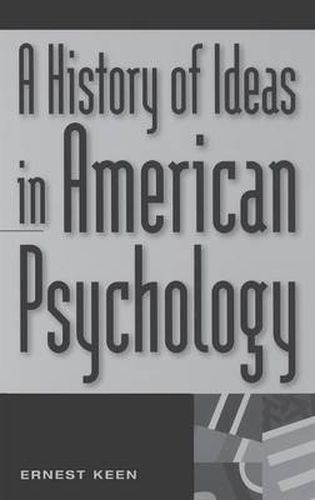Readings Newsletter
Become a Readings Member to make your shopping experience even easier.
Sign in or sign up for free!
You’re not far away from qualifying for FREE standard shipping within Australia
You’ve qualified for FREE standard shipping within Australia
The cart is loading…






This history of ideas in American psychology divides eleven decades into three periods, marked out by specific themes central to psychologists over the years. Initially, the legacy of mind-body dualism challenged scientists to make coherent a single universe of mental and physical phenomena, but efforts were hampered by languages that embody mental and physical metaphysical commitments. This struggle began with James, whose work remains enormously relevant, is exaccerbated by Titchener, whose mentalism provokes a reaction by Watson, whose physicalistic bias provoked a vastly expanded realm opened by Gestalt. The second period, from Freud to Skinner, shifted the focus from mind and body to experimental and clinical settings for the acquisition and application of psychological knowledge. Tolman, Hebb, Rogers, Hull, Piaget, and Skinner each sought to create a psychology that could bridge these two settings, often reducing one to the other, but often inventing ideas for psychology that vastly changed the earlier preoccupation with mind-body dualism. In the third period, feminists, phenomenologists, and post-modern thinkers recentered psychology. The cultural acceptance of psychology, as a point of view on virtually any issue, led to a proliferation of diversity even greater than in the second period. The integration of psychology into employment roles in most segments of society, made psychology more diverse and less unified than ever. An important resource for all scholars, students, and researchers involved with the history of ideas and American psychology,
$9.00 standard shipping within Australia
FREE standard shipping within Australia for orders over $100.00
Express & International shipping calculated at checkout
This history of ideas in American psychology divides eleven decades into three periods, marked out by specific themes central to psychologists over the years. Initially, the legacy of mind-body dualism challenged scientists to make coherent a single universe of mental and physical phenomena, but efforts were hampered by languages that embody mental and physical metaphysical commitments. This struggle began with James, whose work remains enormously relevant, is exaccerbated by Titchener, whose mentalism provokes a reaction by Watson, whose physicalistic bias provoked a vastly expanded realm opened by Gestalt. The second period, from Freud to Skinner, shifted the focus from mind and body to experimental and clinical settings for the acquisition and application of psychological knowledge. Tolman, Hebb, Rogers, Hull, Piaget, and Skinner each sought to create a psychology that could bridge these two settings, often reducing one to the other, but often inventing ideas for psychology that vastly changed the earlier preoccupation with mind-body dualism. In the third period, feminists, phenomenologists, and post-modern thinkers recentered psychology. The cultural acceptance of psychology, as a point of view on virtually any issue, led to a proliferation of diversity even greater than in the second period. The integration of psychology into employment roles in most segments of society, made psychology more diverse and less unified than ever. An important resource for all scholars, students, and researchers involved with the history of ideas and American psychology,